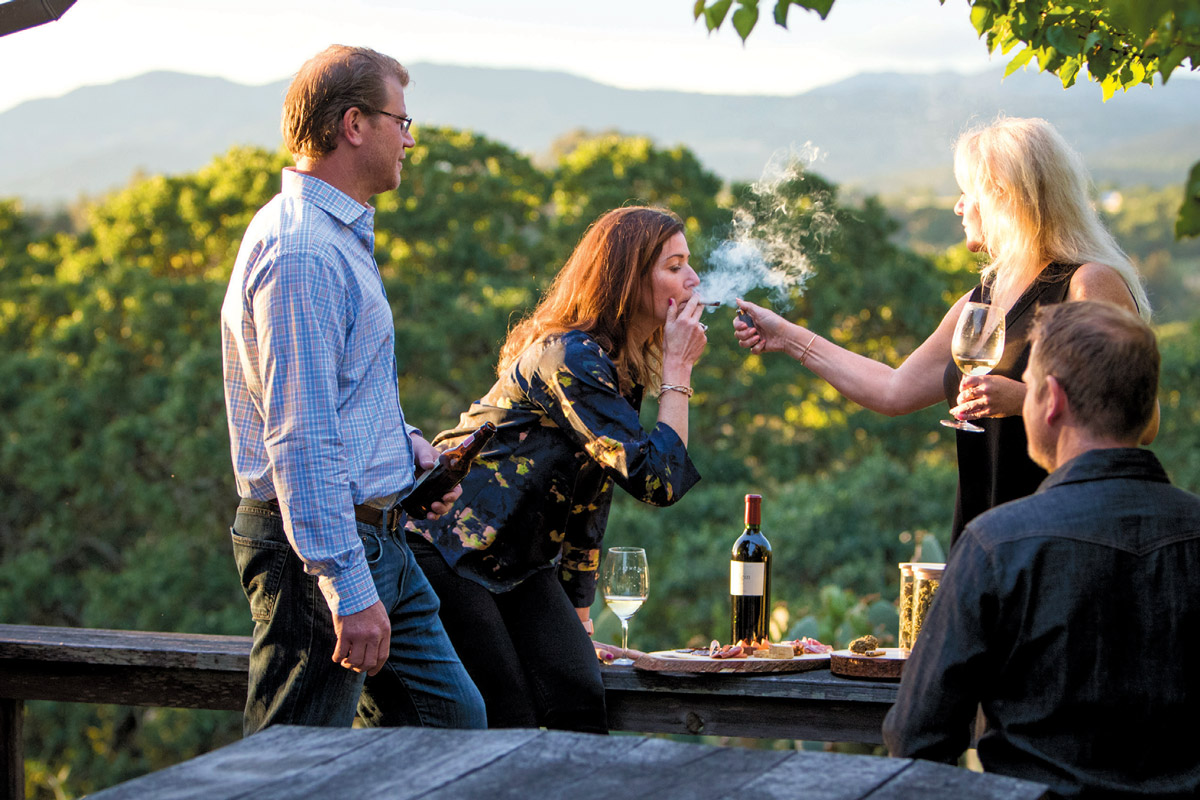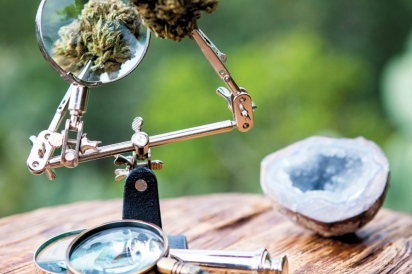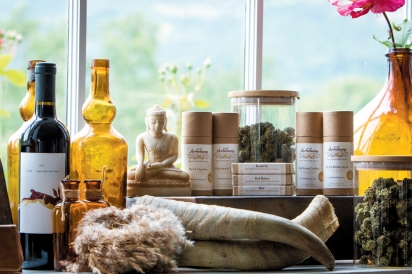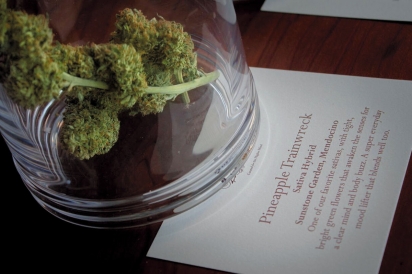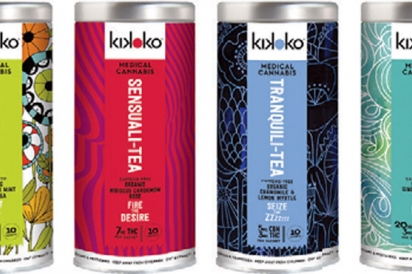Wine Country Gets Kind
NOW HIRING SENSI-SOMMELIERS
I have always liked the idea of pot, but never quite enjoyed the experience of it.
Smoking pot sent me into embarrassing coughing fits, and I never knew how it would affect me—if I’d become catatonic or paranoid, or drowsy, or just binge eat, none of which I wanted more of in my life. Edibles were easier to ingest, but they could be way, way too strong and last for hours.
I’d pass by dispensaries and their glare of bright lights. The characters hanging around outside making them seem a little sinister.
To top it off, I had read about the environmental problems that illegal marijuana farms were causing the rivers in California. In 2014, the magazine Mother Jones published an article titled, “The Landscape- Scarring, Energy-Sucking, Wildlife-Killing Reality of Pot Farming.” This was one of many investigative looks into the rat poison and pesticides used by illegal growers in California during the “prohibition” of cannabis. Not only did they often pollute rivers and create environmental dead zones, but these under-the-radar growers also sucked enormous amounts of water out of drought-starved rivers for their crops. I much preferred a glass of Pinot Noir.
Then I met Alicia Rose, founder of HerbaBuena, a “social club” for cannabis users, at a pop-up tasting at the Wu Wei Tea Temple in Fairfax. Alicia is a blend of business savvy and spiritual earnestness, with a palate honed by years of working with some of Napa and Sonoma’s top wineries and winemakers. Sitting behind the tea counter, Alicia proudly displayed HerbaBuena’s extensive line of cannabis products including infused fruit gelées, smoked almonds, dried fruits and artisanal chocolates. There were hand rolls, along with potions, blends, low-dose tinctures, patches, gels and even products for pets with anxiety.
“Here, you’ll want this, I promise,” she said. She handed me a small bottle of “Quiver,” a “sensual lubricant” made of organic cannabis, cinnamon, clove and coconut oil.
“Oh my,” I said, looking at the small vial. “I had no idea...”
Alicia grew up on a farm in New York, with who she describes as “hippie parents.” While working in Manhattan, she and some friends visited Napa, a trip that she says compelled her to move west. Her first job in Napa was in marketing at Bounty Hunter Rare Wine & Spirits. She went on to work with small, artisanal wineries helping them to develop, brand and market their products.
“There I was, tasting 10 wines a day with brilliant winemakers and professionals in the heart of California,” Alicia gushes. “It was quite an education.”
She expounds that what she learned from winemakers is to search for elegance, harmony and balance both in the process and the product. “There’s an almost intangible, ethereal element to fine wine,” she explained. “It’s about achieving a state of natural balance in the cultivation- a healthy, balanced farming system creates plants, flowers and fruit that are in a greater state of harmony. The best winemakers will tell you that great wine starts in the vineyard.” She now applies this same philosophy to crafting HerbaBuena’s cannabis products.
DEMETER CERTIFIED CANNABIS
HerbaBuena has its own small, permitted cannabis garden in Mendocino County, and they also work with farmers in Sonoma County who grow cannabis using biodynamic methods. This past fall, in fact, HerbaBuena launched their line of Demeter certified, biodynamic cannabis products. A first in the industry, according to Alicia. Demeter certification exceeds organic standards in terms of sustainable farming practices. The designation “organic” can’t be applied to cannabis, as “organic” is a USDA designation and cannabis is still illegal at the federal level.
Steve Terre, owner of Redtail Ranch in Sebastopol, has grown olives to press into oil for the past 20 years, and is now also growing cannabis. He has always farmed organically, but three years ago he received his biodynamic certification from the Demeter certifying organization. This means that he does not use any pesticides on his entire farm, and all other soil inputs (such as fertilizers) have to come from the farm itself. His animals—horses, goats, sheep, llamas, chickens and bees— all get to work, weeding, fertilizing and pollinating.
Another critical difference in growing cannabis using biodynamic methods is that it must be grown outdoors, over the course of a full, natural growing season. Because of this, Steve harvests one crop per year, unlike greenhouse-grown cannabis. He explained, “If you’re growing these plants in a warehouse under lights, you can get four harvests a year, as the artificial environment forces the flowering. But if you consider this plant medicine, then letting it grow naturally by sunlight over time means that it develops its full healing properties. As well, it captures the energy of the moon—this is a powerful celestial force.”
“We can’t compete with the guys growing warehouses full,” Steve says. “It’s like drinking Gallo wine from Modesto versus Merry Edwards from Occidental. The products are nothing alike.”
What does all this mean for the consumer experience? When we met at the Wu Wei Temple, Alicia told me that when she smoked cannabis that had been grown indoors, it made her feel claustrophobic. “The plants are crowded and stressed, so that’s what you get from them. These are sacred medicine plants,” she said. “So we treat them with respect and allow them to have their full healing potential.”
CANNABIS AS MEDICINE
This all may sound a little woo-woo, but more and more studies confirm that cannabis has remarkable healing properties that are really just starting to be understood.
Cannabis plants contain hundreds of chemical compounds called cannabinoids. Of these compounds, there’s cannabidiol (CBD), which is nonpsychoactive and has a wide range of medical benefits, including reducing blood sugar and controlling epileptic seizures. There’s also CBN, CBG and CBC, all with healing properties. The best-known cannabinoid is tetrahydrocannabinol (THC). This gets you high, but it too has valuable medicinal properties and studies are showing it’s an antioxidant, can inhibit the growth of cancer cells, increase appetite and quell nausea.
The reason this plant compound integrates so well into human bodies is that the shape of the THC molecule is remarkably similar to the shape of molecules, now called “endocannabinoids,” that occur naturally in humans. The discovery of plant THC by Raphael Mechoulam, an Israeli biochemist, in the 1960s led to studies of whether human bodies produced similar compounds. Turns out, we do. The endocannabinoid system operates through a complex map of cell receptors that communicate between the brain and different systems in our body—such as nervous, muscular, immune, reproductive and others—to facilitate health. THC taps into this “endo-” meaning “within,” system, enabling it to be used to treat a body-wide array of symptoms, from depression to anorexia.
THERE ARE LIMITS
Staci Gruber, an associate professor of psychiatry at Harvard, has been studying the effects of cannabis for about two decades and founded the Marijuana Investigations for Neuroscientific Discovery (MIND) Program at McLean Hospital/Harvard Medical School.
Gruber and other researchers have found that when kids use cannabis before their early or even mid-20s, when their brains are still developing and more vulnerable, it can have long term detrimental effects such as attention deficits, lower IQ scores and increased impulsivity. (For more on this important research, see the article Marijuana and the Developing Brain published in the November 2015 Monitor on Psychology, a publication of the American Psychological Association: http://www.apa.org/ monitor/2015/11/marijuana-brain.aspx.) Notably, cannabis smoked “recreationally” by young people is often bred for maximum psychoactive impact, meaning it would contain very high levels of THC.
On the other hand, Gruber has found very different results with adults who used medical cannabis that often had a higher ratio of CBD to THC. In fact, they exhibited improved results on tasks mediated by the frontal cortex. She also showed that it can possibly ease symptoms for people with bi-polar disorder.
Julie Holland, author of The Pot Book: A Complete Guide to Cannabis, refers to cannabis as a “painkilling, anti-inflammatory, metabolism-regulating, cancer-killing, heart-opening medicine.” In a telephone call she explained that she’s fighting in New York to be able to prescribe whole flowers to her patients with PTSD—all the chemicals in cannabis working together is known as the “entourage” effect. “The whole flower has a symphonic effect,” she explained. “It’s a complex ecosystem. I think it’s important to have all the chemicals there, as they once naturally occurred. The answer is not for a lab to take out all the THC. This takes away the flower’s magic and power. It’s what makes the symphony work.”
Out back at the Wu Wei Temple, cannabis flowers were displayed under beautiful glass cloches. Each was accompanied by tasting notes including descriptors like “grape and purple pine,” “heirloom strain” and “bright high.” The HerbaBuena “sensi-sommelier” standing by the display advised guests, most of whom appeared to be in their 40s and 50s, to note the “flower with fruit” in one strain, and the “earthly, marigold nose” in another. “Tasting” was offered via mini hand rolls, vaporizers or whole flowers.
After sampling mini hand rolls (and still coughing) and vaporizers (not coughing) my friends and I made our way to local wine bar 123 Bolinas for the best cheese plate I’ve ever had.
I’m not going to quit Pinot anytime soon, but experiencing cannabis in this entirely different way moved me from being largely uninterested to highly appreciative of this crop of wine country experts who are lending their expertise and experience at creating balance and elegance in an artisan- crafted product to an emerging, post-prohibition cannabis industry.
MOVE OVER CHAMOMILE, THERE’S A NEW HERB(AL) TEA IN TOWN
Sausalito-based Kikoko Teas’ story began four years ago when Jennifer Chapin and Amanda Jones’s mutual friend was diagnosed with ovarian cancer. Cannabis helped the friend with pain management, subdued her nausea and increased her appetite, but she didn’t like to smoke it, and edibles had very inconsistent dosing.
“She was literally knocked to her knees by edibles that were too strong,” says Chapin. “We wanted to create a product with a very consistent, reliable dose that’s healing, but mild, so people can function. We’ve worked with five different scientists to isolate different CBDs and also make them water-soluble. This element is very important to the teas for consistent dosage and has never been done before.”
Jones notes that they also worked very hard to find reliable, consistent sources of cannabis. “We work with two women growers in Mendocino who cultivate only sun-grown, organically grown cannabis. If you want to use this for healing, you don’t want pesticides in it.” Being grown outdoors in the sun also reduces or eliminates mold, something else you don’t want to ingest.
This spring, Chapin and Jones introduced the first Kikoko Teas whole-flower organic teas containing low doses of cannabinoids CBD, THC and CBN.
The teas are expertly blended and beautifully packaged, with the recommended use and dosage clearly labeled. “Sympa-Tea,” a ginger-turmeric-orange blend, has 20 milligrams of CBD and 3 of THC. These help with pain and cramps. “Positivi-Tea is a lemongrass and mint tea that has 5 mg of THC and 10 of CBD to brighten your mood. “Sensuali-Tea” has 7 mg of THC and 10 ml of CBD, and its intent is to boost the libido, (the tag line is “Find Your T-Spot”). Tranquili-Tea is formulated for sleep with 3mg THC and 5mg CBN.
Chapin and Jones believe their teas are the first of their kind, at least for sale commercially. Jones points out that the teas are intended to be an easy entry for people who want to use cannabis to medicate, as most people are already familiar with tea.
When the venture began, the dispensaries they contacted said they wouldn’t be interested in carrying the teas since they contained such low doses of THC. But Jones and Chapin carried on, believing in the potential of reaching non-traditional cannabis users. “Our teas are for people who want a little help sleeping, or who might have cramps, or desire a libido boost during menopause,” she explains. “These aren’t for traditional stoners. We gambled that low-dosage users are a big potential market.”
“A lot of the products at dispensaries are 1:1 CBD to THC ratio,” Chapin notes. “Some of our teas have 20 milligrams of CBD to 3 of THC, and we are working on one that’s 80 parts CBD to 2 parts THC. This will be so very, very mild that my 81-year-old mother is looking forward to trying it.”
It’s a sign of the times that, according to Jones, dispensaries are now anxious for their teas as demand grows for artisanal, low-dose cannabis products. “There’s a ceremony and tradition to both teas and cannabis,” Chapin explains. “Besides, chocolate is already being done so well.”
At “High Tea” parties the duo hosts to introduce their products, they sell out of all their stock on hand. “The guests were middle-aged moms from my suburban neighborhood,” Jones says. “The demand was huge. We were blown away.”
To find out what the name Kikoko means (they made it up), and learn more about their teas, visit Kikoko.com.
Maria Finn is a journalist, author and maker maven. She lives on a houseboat in Sausalito where she has a native oyster garden and believes that bi-valves make great pets. Find her at MariaFinn.com


